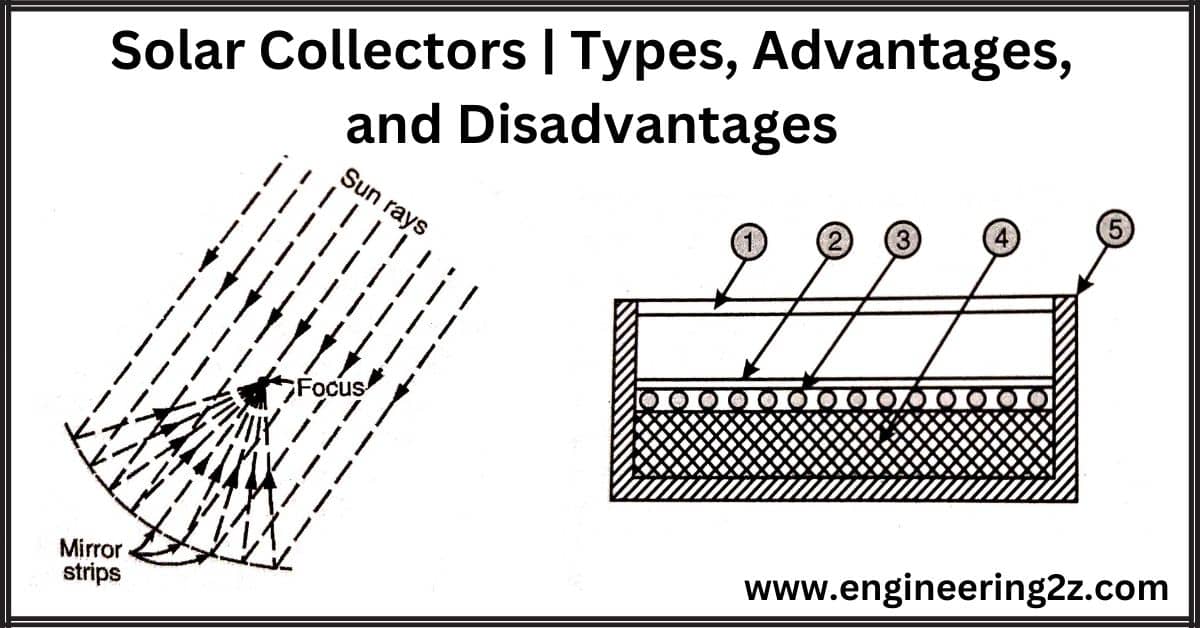
Table of Contents
Solar Collector
Solar energy collectors are crucial for converting solar radiation into usable forms like heat or electricity. There are two main types of collectors: non-concentration and concentrating collectors.
In non-concentration collectors, the collector area and absorber area are the same. These collectors intercept solar radiation and absorb it without concentrating it.
Concentrating collectors, however, have a larger area for intercepting solar radiation compared to the absorber area. They use mirrors and lenses to focus the sun’s rays on a boiler, allowing for much higher temperatures. This type of collector is more efficient than non-concentration collectors.
To maximize efficiency, it is important to mount the collectors in a way that they face the sun as it moves across the sky.
Overall, solar energy collectors play a vital role in harnessing solar radiation and converting it into proper energy forms. There are mainly two types of collectors:
- Non Concentrating Collectors
- Concentrating Collectors.
1. Non Concentrating Collectors
In these collectors, the area of the collector to intercept the solar radiation is equal to the absorber plate and has a concentration ratio of 1. These collectors are further classified as:
- Flat Plate Collectors: Fixed tilted non-concentration collectors are used for temperatures below 100 °C. They can utilize both direct and diffuse solar radiation. These collectors are installed in a fixed tilted position, ideally facing the equator, to maximize efficiency and capture sunlight throughout the day.
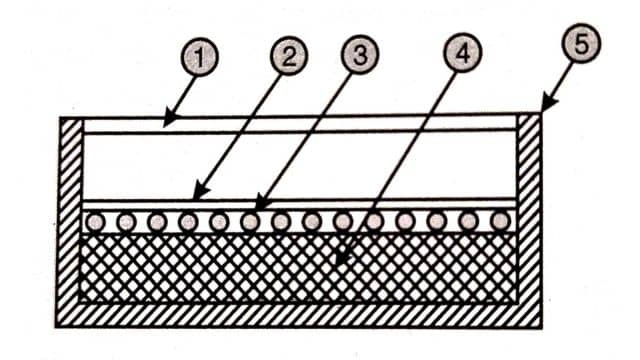
The main parts of a flat plate collector are:
- A see-through cover: This can be made of glass or a transparent plastic sheet that allows sunlight to pass through.
- Tubes, fins, passages, or channels: These are connected to the absorber plate or integrated with it. They carry water, air, or another fluid to transfer heat.
- The absorber plate: It is usually made of metal or has a black surface. It absorbs the solar energy and converts it into heat. Different materials can be used for air heaters.
- Insulation: This is placed at the back and sides of the collector to minimize heat loss. Common insulating materials like fiberglass or styrofoam are used for this purpose.
- The casing or container: It encloses all the other components and protects them from the weather.
In simple terms, a flat plate collector has a clear cover, tubes or channels for fluid, a plate that absorbs heat, insulation to prevent heat loss, and a protective casing.
2. Liquid Collector:
A liquid collector is a type of solar collector that consists of a flat surface designed to absorb solar radiation. The absorbing surface is typically a metal plate made of materials like copper, steel, or aluminum, with copper tubes in thermal contact with the plate. The absorber plate is usually 1 to 2 mm thick, while the tubes range in diameter from 1 to 1.5 cm. They are connected to the bottom of the absorber plate with a spacing of 5 to 15 cm.
To transfer heat to a point of use, fluid (typically water) is circulated across the solar-heated surface. Thermal insulation, usually 5 to 10 cm thick, is placed behind the absorber plate to minimize heat loss. Insulation materials such as mineral wool, glass wool, or fiberglass are commonly used.
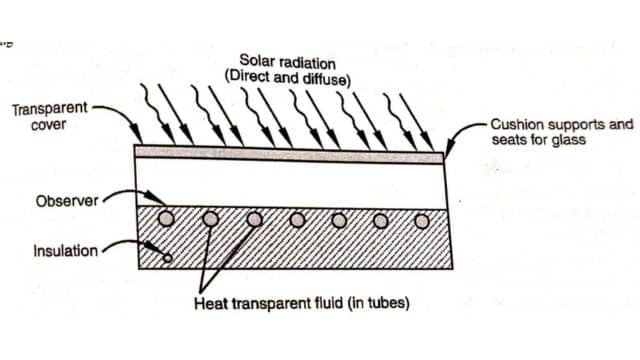
The front cover, usually made of glass or transparent plastic, allows solar radiation to enter but blocks infrared re-radiation from the absorber. The glass cover acts as a shield against convection losses from the absorber plate. Glass is the preferred material, typically with a thickness of 3 to 4 mm. However, certain plastic films may also be suitable.
In summary, a liquid collector consists of an absorbing surface made of a metal plate and tubes, fluid circulation for heat transfer, insulation to reduce heat loss, and a front cover (usually glass) that allows solar radiation to pass through while minimizing convection losses.
3. Typical Air collectors or Solar Air Heater:
A flat plate collector used for heating an air stream consists of a plate with attached fins on the back side to increase contact surface area. The back side of the collector is heavily insulated with materials like mineral wool. The most favorable orientation for heating purposes is facing due south, inclined at an angle equal to the latitude plus 15º.

Air is sometimes used as the heat transport medium in solar collectors, offering advantages over water. To reduce the power needed for air circulation, wider flow channels are used, such as spaces between the absorber plate and insulator with baffles creating a zig-zag flow path. Air eliminates freezing and corrosion issues and small air leaks are less concerning than water leaks. Additionally, heated air can be directly used for space heating. However, air requires larger duct sizes, higher flow rates, and increased pumping power than water. Heat transfer from air to water in a hot water supply system is also inefficient.
Solar air heaters are essential for utilizing solar energy and find applications in drying agricultural products, space heating, dehumidifying agent regeneration, timber seasoning, and curing industrial products like plastics.
Applications of Solar Air Heater:
(1) Heating buildings.
(i) Drying agricultural produce and lumber.
(ii) Heating greenhouses.
(iv) Air conditioning buildings utilizing desiccant beds or absorption refrigeration process.
(e) Using air heaters as the heat sources for a heat engine such as a Brayton or Stirling cycle.
2. Concentrating Collectors
A focusing collector is designed to capture solar energy with high intensity by using optical systems like reflectors or refractors. It is a modified version of a flat plate collector, where a reflecting or refracting surface (known as a concentrator) is introduced between the solar radiation and the absorber. These collectors can significantly increase the radiation intensity from a low value to a much higher value, sometimes up to 10,000 times. They focus the solar radiation from a large area onto a smaller receiver or absorber. This concentration of energy allows fluids to be heated to temperatures of 500 °C or even higher.
Types of Concentrating Collectors
Two general categories of concentrating collectors are:
(A) Line-focusing types
(B) Point focusing types The line is a collector pipe and the point is a small volume through which the heat transport fluid flows.
As per the number of concentrating collector geometries, the main types of concentrating collectors are
(a) Parabolic trough collectors.
(b) Mirror strip reflector.
(c) Fresnel lens collector.
(d) Flat plate collector with adjustable mirrors.
(e) Compound parabolic concentrator (C.P.C.)
A) Line-focusing collectors:
1. Parabolic Trough Reflector: In concentration, collectors like the parabolic trough collector, solar radiation is collected and concentrated at the focus of a parabolic reflector. The reflector is shaped like a trough with a parabolic cross-section, causing the solar radiation to be focused along a line. The absorber, usually a collector pipe with a selective absorber coating, is placed at the focus to capture the concentrated solar energy.
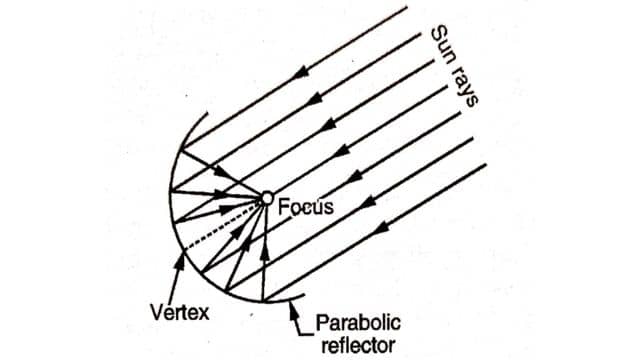
Parabolic trough collectors can vary in size, with reflector units typically being 3 to 5 meters long and 1.5 to 2.4 meters wide. Multiple units are often connected in a row or in parallel. Reflectors are commonly made of polished aluminum or silvered glass.
2. Mirror Strip Reflector: A solar trough concentrator consists of a plane or slightly curved mirrors mounted on a flat base, reflecting solar radiation onto a fixed focal line. The mirrors are adjusted to account for changes in the sun’s elevation, while the collector pipe remains in the focal line.
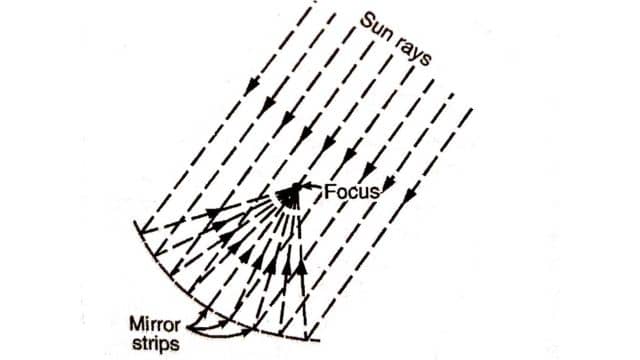
3. Fresnel Lens Collector: Fresnel lens-based collectors use the focusing effect of a rectangular lens, typically 4-7 meters long and 0.95 meters wide. The lens is made in sections from acrylic plastic and is cost-effective. The trough container does not contribute to concentrating solar energy.

B) Point focusing collector (Paraboloidal Type):
A paraboloidal dish collector concentrates solar radiation by bringing it to a focus at a small central volume. The dish, about 6-6 meters in diameter, is made of curved mirror segments forming a paraboloidal surface. The absorber cavity, located at the focus, is made of a zirconium copper alloy with a selective coating. The collector tracks the sun to maintain alignment with the focus, allowing for continuous solar tracking.
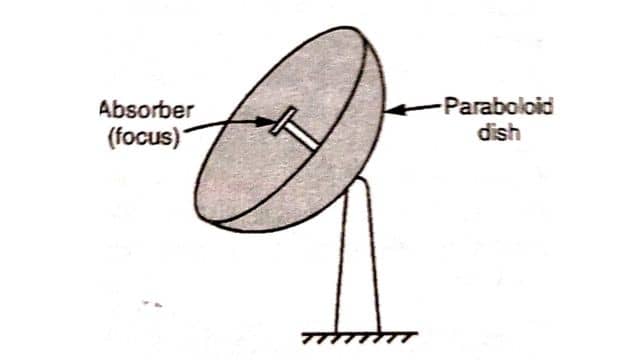
4. Concentrating Collectors, Non-Focusing type: A reflective flat plate collector consists of a south-facing flat plate with mirrors attached to its north and south edges. When the mirrors are set at the correct angle, they reflect solar radiation onto the absorber plate. This allows the absorber plate to receive both direct solar radiation and reflected radiation from the mirrors. By reflecting and redirecting scattered radiation onto the absorber, the mirrors enhance the concentration effect. The main advantage comes from the increased direct radiation reaching the absorber plate, resulting in improved efficiency.
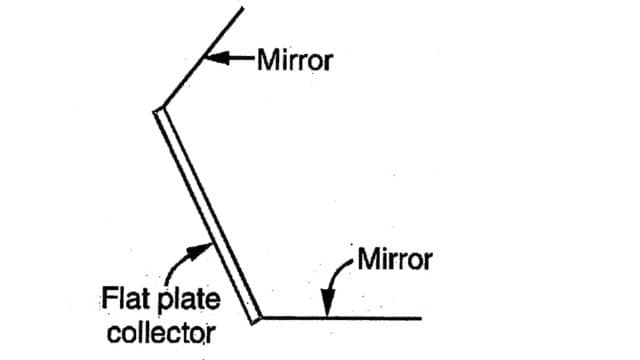
Due to sun shading caused by mirror extensions, multiple collectors in rows need to be set further apart in the north-south direction. Continuous angle adjustments and limited increases in solar radiation make flat plate collectors with mirrors less common.
5. Compound Parabolic Concentrator (C.P.C.): The C.P.C. (Compound Parabolic Concentrator) is a trough-like arrangement of two parabolic mirrors. Unlike single parabolic troughs, the C.P.C. collects solar radiation from various directions, including diffuse radiation, concentrating it on a small area. It offers a moderate concentration in the east-west direction without constant sun tracking.

Advantages and Disadvantages of Concentrating Collectors over Flat Plate Type Collectors
Advantages of Concentrating Collectors over Flat Plate Type Collectors:
- Higher Temperature Output: Concentrating collectors can achieve much higher temperatures compared to flat plate collectors, making them suitable for applications requiring high-temperature heat or steam generation.
- Improved Efficiency: Concentrating collectors have better efficiency in capturing and converting solar radiation into usable energy, thanks to their focusing or concentrating mechanisms.
- Compact Design: Concentrating collectors can achieve higher energy output with a smaller surface area compared to flat plate collectors, making them more space-efficient.
- Versatility: Concentrating collectors can be used for a variety of applications, including power generation, industrial process heat, and solar thermal technologies.
- Reduced Material Usage: Due to their smaller surface area, concentrating collectors require less material for construction, which can lead to cost savings.
Disadvantages of Concentrating Collectors over Flat Plate Type Collectors:
- Complexity and Cost: Concentrating collectors involve more complex designs, including mirrors or lenses, which can increase their manufacturing and installation costs.
- Tracking Requirements: Concentrating collectors often require sun-tracking mechanisms to maintain optimal alignment with the sun’s position, adding complexity and potential maintenance requirements.
- Limited Acceptance of Diffuse Radiation: Concentrating collectors are more reliant on direct solar radiation and may not effectively capture diffuse or scattered sunlight, limiting their performance on cloudy or overcast days.
- Higher Maintenance: Concentrating collectors with moving parts, such as sun-tracking systems, may require regular maintenance and calibration to ensure optimal performance.
- Potential for Glare: Concentrating collectors can produce intense beams of focused sunlight, which may pose a glare hazard for nearby structures or occupants if not properly managed.
Advantages of Solar Collector
- Renewable Energy: Solar collectors use energy from the sun, which is a limitless and renewable resource.
- Good for the Environment: They help reduce pollution and lessen the need for fossil fuels, making the planet cleaner.
- Saves Money: Solar collectors can cut down on energy bills, especially in sunny areas.
- Energy Independence: They reduce the need to rely on outside energy sources, making you more self-sufficient.
- Long Lasting: With proper care, solar collectors can work efficiently for many years.
- Government Support: Many places offer financial help, like rebates and tax credits, for installing solar collectors.
Frequently Asked Questions (FAQs)
What is a Solar collector?
A solar collector is a device that harnesses the energy from sunlight and converts it into usable heat or electricity.
What is Line focusing collectors?
Line-focusing collectors are solar energy collectors that concentrate solar radiation onto a narrow line or focal point for heat generation.
What is Point focusing collector?
A point-focusing collector is a type of solar energy collector that concentrates solar radiation onto a single point or small focal area for heat generation or power production. These collectors typically use mirrors or lenses to focus sunlight onto the focal point, which can reach high temperatures and be used for various applications such as steam generation or electricity production through solar power towers or Stirling engine systems.
How many types of collectors are there?
There are mainly two types of collectors:
Non Concentrating Collectors
Concentrating Collectors.
Related Posts
- Travelling Wave Tube | Construction, Working and Applications
- Radar | Types of Radar, Advantages and Disadvantages
- Radar | Block Diagram, Working Principle and it’s Applications
- Multiple Access Techniques for Wireless Communication
- Internet of Things | Functional Block of IoT, Characteristics and Application
- Microphone | Types, Block Diagram, and its Working
















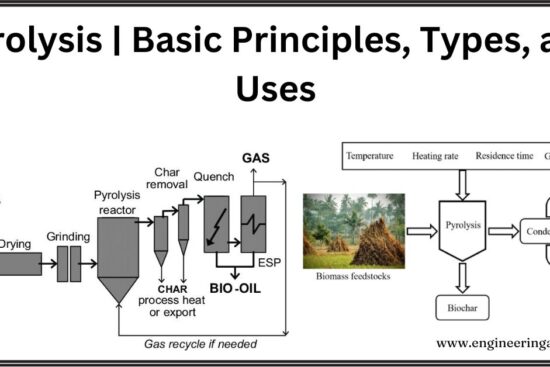
Leave a Reply